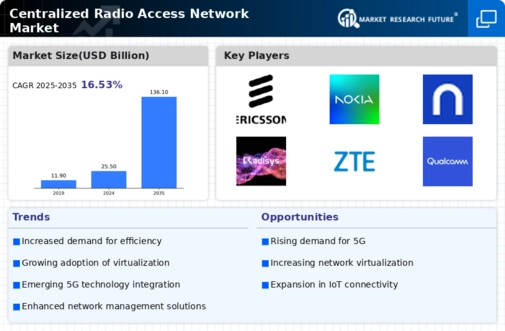Advancements in 5G Technology
Advancements in 5G technology significantly influence the Global Centralized Radio Access Network Market Industry, as the rollout of 5G networks necessitates innovative infrastructure solutions. Centralized radio access networks enable operators to manage resources more effectively, thereby optimizing network performance. The anticipated growth of the market to 136.1 USD Billion by 2035 reflects the increasing investment in 5G infrastructure. This transition not only enhances mobile broadband services but also supports emerging applications such as autonomous vehicles and smart cities, which rely heavily on high-speed, low-latency connectivity.
Increased Focus on Network Security
The heightened focus on network security is becoming a significant driver in the Global Centralized Radio Access Network Market Industry. As cyber threats evolve, operators are compelled to implement robust security measures within their network architectures. Centralized radio access networks offer enhanced security protocols, enabling better monitoring and management of potential vulnerabilities. This emphasis on security is likely to influence investment decisions, as organizations prioritize secure connectivity solutions to protect sensitive data and maintain user trust in an increasingly digital landscape.
Growing Demand for High-Speed Connectivity
The Global Centralized Radio Access Network Market Industry experiences a surge in demand for high-speed connectivity driven by the increasing number of connected devices and the proliferation of IoT applications. As organizations and consumers seek faster and more reliable internet access, the market is projected to reach 25.5 USD Billion in 2024. This growth is indicative of the industry's response to the escalating need for bandwidth, particularly in urban areas where data traffic is dense. The integration of centralized radio access networks facilitates efficient spectrum utilization, thereby enhancing overall network performance and user experience.
Cost Efficiency and Operational Flexibility
Cost efficiency and operational flexibility are pivotal drivers in the Global Centralized Radio Access Network Market Industry. By centralizing network functions, operators can reduce capital and operational expenditures, which is particularly appealing in a competitive landscape. The ability to deploy resources dynamically allows for better allocation based on demand fluctuations. This operational model is expected to contribute to a compound annual growth rate of 16.45% from 2025 to 2035, as organizations increasingly recognize the financial benefits of adopting centralized architectures.
Regulatory Support for Network Modernization
Regulatory support for network modernization plays a crucial role in shaping the Global Centralized Radio Access Network Market Industry. Governments worldwide are advocating for the adoption of advanced telecommunications technologies to enhance national competitiveness. Policies promoting infrastructure investment and spectrum allocation facilitate the deployment of centralized radio access networks. This supportive regulatory environment is likely to accelerate market growth, as stakeholders align their strategies with national objectives aimed at improving connectivity and fostering innovation in telecommunications.

























Leave a Comment